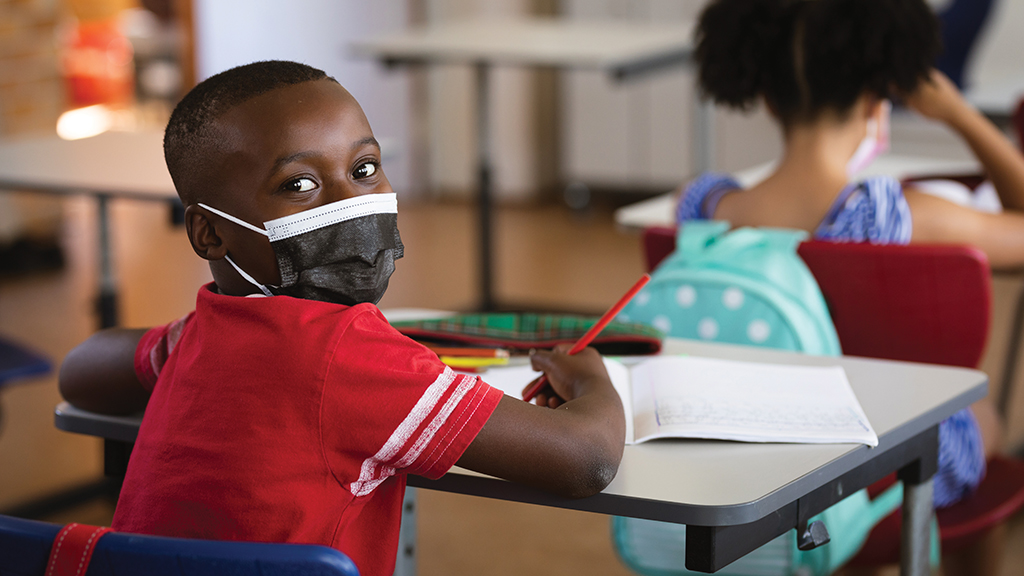
Photo credit: WAVEBREAK3/STOCK.ADOBE.COM
COVID-19 has spread to every state and inhabited county in the U.S. According to the U.S. Department of Agriculture (USDA), by June 7, 2021, the regions with the highest prevalence of cumulative COVID-19 cases included much of the Midwest and the South and parts of the Mountain region of the western United States.
Data published by the Centers for Disease Control and Prevention (CDC) shows that higher COVID-19 case rates have been observed in certain minority populations, including Hispanics/Latinos and American Indian/Alaska Natives. Sadly, many rural low-income school districts are in these seriously affected areas.
This fall, nearly all public schools resumed to operate offering in-person instruction full time, four or five days a week. How did rural, low-income school districts fight the pandemic and help students to return to school safely? How responsive were school districts (in the areas we studied) to community sentiment regarding COVID-19?
To answer these questions, the Center for Public Education investigated 338 school districts defined as rural schools by both federal and state governments and currently participate in the Rural and Low-Income School (RLIS) program. At least 20% of the children they serve come from families with incomes below the poverty line.
Among all the districts we studied, more than 40% of students are from low-income households. For instance, 35% of the districts in Maine, 39% of the districts in Ohio, and 73% of the districts in Montana have more than a quarter of students living in poverty.
Among the districts we studied, 77% have COVID-19 mitigation plans posted on their websites, which include policies in areas such as screening at home/school, face coverings, social distancing, good hygiene practices, testing/tracking/tracing, quarantine, school bus protocols, and air quality and ventilation of school buildings. By late September, approximately 43% have required students and staff to wear face masks in the new school year.
Safety in numbers
We used the ZIP code of each RLIS district to retrieve two variables—the population COVID infected rate (by 9/24/2021) and the estimated COVID-19 vaccine hesitancy rate (by 6/24/2021). According to researcher Ryan Barber, the vaccine hesitancy rate refers to the proportion of people in the ZIP code who have not been vaccinated and are not ready to take the vaccines.
For the RLIS districts we studied, the median vaccine hesitancy rate is 22.8%, with a range from 0.3% to 62.9%. The median of the COVID-19 case rate is 11.8%, with a range from 0 to 27.3%.
After conducting a linear regression, we found that the COVID-19 infected rate is positively associated with the vaccine hesitancy rate, namely the higher the hesitancy rate, the higher the infected rate. Without considering other pandemic-related factors, this statistical result suggests that in the ZIP code or county where an RLIS school district is located, the more people vaccinated or willing to be, the more likely the area had fewer COVID-19 cases, and the more likely students can return to in-person instruction safely.
Vaccine hesitancy and mask policies
In a January study by the CDC, researchers analyzed data of 4,876 students and 654 staff members who participated in in-person learning in 17 K-12 schools in rural Wisconsin. They found that in schools with more than 92 percent of students wearing face masks, COVID-19 case rates among students and staff members were lower than the county’s overall case rate. The study suggests that, with proper mitigation strategies, K-12 schools might be capable of opening for in-person learning with minimal in-school transmission of the virus.
The reality is that nationwide, a debate is raging as to whether schools should require all students to wear face masks. While those incidents did not necessarily take place in rural areas, we think that answers to the following research question may provide some insight into the situation.
Are the local COVID-19 vaccine hesitancy rates how the community feels about vaccination associated with how the schools set their mask-wearing policies? The data suggest the answer is yes. Using logistic regression models, after controlling for contextual variables (i.e., state, district enrollment, and county COVID-19 case rate), we found that there is a significant inverse relationship between schools’ face mask policies and the local vaccine hesitancy rate. The lower the percentage of vaccine hesitancy in the community, the more likely the schools will mandate wearing face masks.
While our data has limitations, our findings suggest that wearing facial coverings seems to provide significant protection against the spread of COVID-19 among students and school staff. This result is consistent with other research studies. Anecdotally, the issue of some people disagreeing with mandates seems to have more to do with the perception of an imposition than with deep disagreements over the effectiveness of facial coverings.
Our data analysis also shows that, when making decisions about measures to mitigate the pandemic, school districts do seem to take in serious consideration community attitudes and sentiments. As time passes, more research will be published on the effectiveness of COVID-19 vaccination to end the pandemic. Our qualitative data of the 338 RLIS districts show that some districts have already started a stronger, research-based campaign to educate their constituents about the effectiveness of mitigating measures rather than resorting to potentially controversial mandates.

Share this content